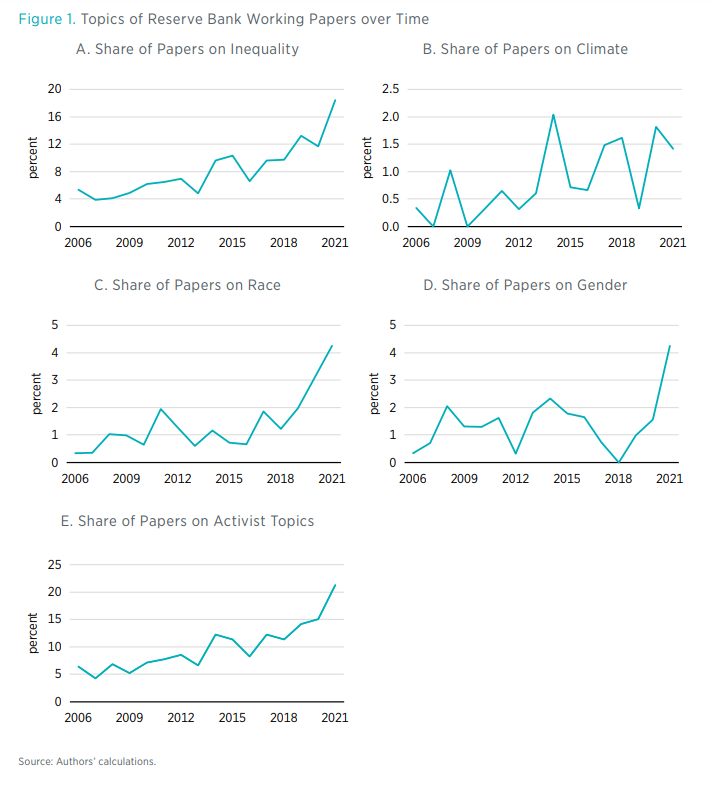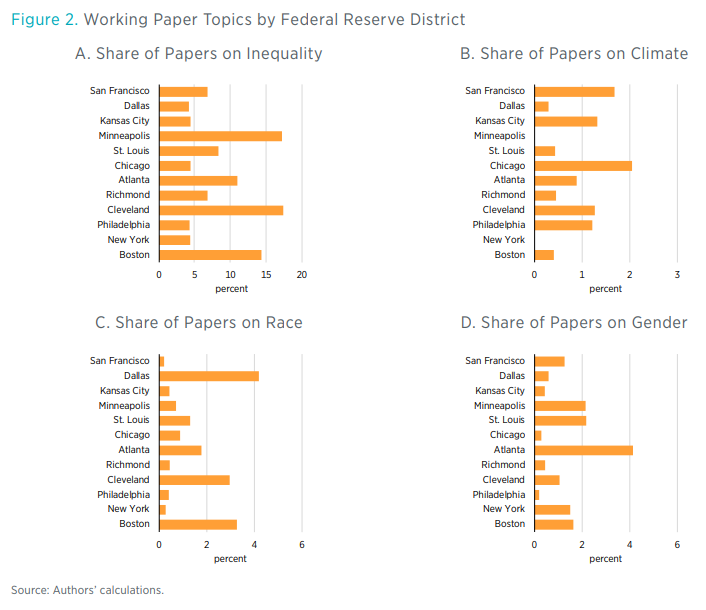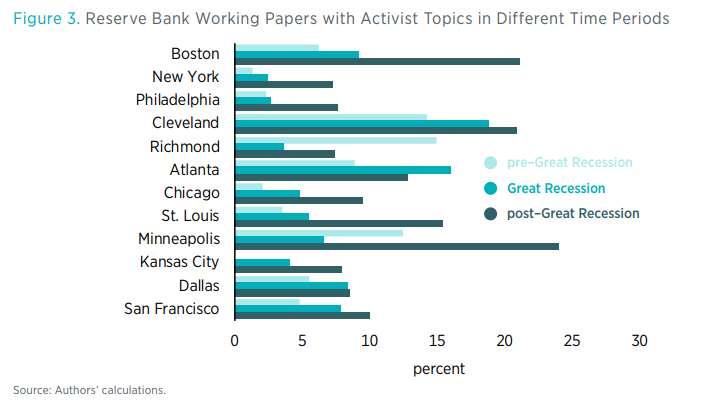- | Monetary Policy Monetary Policy
- | Policy Briefs Policy Briefs
- |
Mission Critical or Mission Creep? The Research Function of the Federal Reserve Banks
Research is a core function of the Federal Reserve (Fed). The Board of Governors of the Federal Reserve and reserve banks have large and well-resourced research staffs, whose work both informs Fed policy and constitutes part of the Fed’s communication with the public.
Recently, however, the research function of the Fed has come under scrutiny. Some members of the Senate Committee on Banking, Housing, and Urban Affairs have expressed concern about the “increasing focus on politically-charged issues” in the research agendas of several of the reserve banks, raising questions about whether the reserve banks are overstepping the bounds of their statutory mandates and risking inflicting reputational damage on the Fed system as a whole. But to date, there has been very little scholarship discussing the legal structure, governance arrangement, and empirical landscape of the research function of the Fed. As a result, few understand what drives the intellectual environment and policy agendas across the Fed system. To fill this gap, we draw together primary source documents and a new dataset to study the research function of the Fed from its founding through the present day. We wanted to investigate whether the research agenda has changed over time—whether there is more focus on controversial or activist issues—and whether the individual reserve banks have substantially different research agendas. Here we present some highlights from our research, which is forthcoming in the Review of Banking and Financial Law.
Origins and Evolution of the Research Function
Research departments at the board of governors and at the 12 reserve banks were established shortly after the enactment of the Federal Reserve Act of 1913 for the purpose of collecting data and reporting on regional conditions and member banks’ conditions. Since then, the research function has expanded in depth, scale, and scope. The volume of research produced by the reserve banks and the board is nearly 20 times that produced by other regulators, such as the Financial Stability Oversight Council and the Securities and Exchange Commission. The research outputs of the reserve banks especially have long contributed to the vibrant intellectual foundation of the Fed and have driven an ethos around thought leadership, education, and outreach.
At times, the research function of the reserve banks has proven controversial. For example, during the Cold War in the 1950s, Congress expressed concern about reserve banks’ efforts to influence public opinion on “controversial matters.” The board underscored that the purpose of the research is not to influence public opinion but to inform policy and communicate the expert basis of its decisions to the public:
A dual purpose is served by the economic studies of the Board of Governors and the Federal Reserve Banks. They guide the System in the formulation and administration of credit and monetary policy, which requires a welding of national and regional considerations . . . . At the same time, by making the bulk of these materials available in its publications, the System helps to keep the public fully informed. Largely statistical in character, often accompanied by interpretative commentary, the System’s reports serve to provide better general understanding of the functioning of the economy. They are meant to be objective, authoritative, and comprehensive discussions of economic trends.
Later, the Community Reinvestment Act (CRA) of 1977 may have provided some political cover for the expansion of the Fed’s research. The CRA aimed to ensure that low- and moderate-income families have sufficient access to credit. The law requires the Fed to assess member banks’ track records of making loans to those groups. The board delegated most of this responsibility to the reserve banks, which were better able to develop “first-hand knowledge” through “regular contact with local organizations.” The reserve banks, in turn, took on new community development functions, which in some cases operated in tandem with the research function.
Over time, most reserve banks expanded their community development programs to consider broader questions of community economic health. For example, the Federal Reserve Bank of San Francisco states that “our economy can only reach its full potential when everyone is educated, healthy, and has an affordable place to call home. Addressing the long-standing challenges that limit opportunity requires collaboration across sectors and disciplines.” The Federal Reserve Bank of San Francisco considers research on climate risks and climate-related outcomes to be an important part of understanding community economic health.
More recently, Ranking Member Pat Toomey of the Senate Committee on Banking, Housing, and Urban Affairs accused the reserve banks of San Francisco, Atlanta, Boston, and Minneapolis of “woke mission creep,” owing to their publications on climate change, race, and inequality. Other commentators have warned that a more activist agenda has the potential to politicize the Fed by taking the institution outside the bounds of its mandate. For example, John McGinnis argues that “currently, the Fed is considering undertaking new roles in such divisive issues as climate change and inequality. The experience of the Supreme Court suggests that those controversial initiatives are likely to exacerbate an already nascent polarization.” Even if the Fed does not take on new policy roles in these areas, a research agenda that focuses on controversial issues could confuse and mislead members of the public who are less informed about the mandate and policies of the Fed.
Empirical Methods and Results
To examine how the research agendas of the reserve banks have evolved over time and how they differ among individual reserve banks, we needed an empirical dataset measuring the research agendas of the reserve banks over time. We chose to focus on the academic-quality working papers, which are publicly available on the reserve bank websites and often go on to be presented in conferences or seminars and published in academic journals. We hand collected data on the nearly 5,000 working papers published by all twelve banks since 2006, covering all years when Ben Bernanke and Janet Yellen chaired the Fed and covering part of Jerome Powell’s tenure as chair.
For each working paper, our research assistants recorded the Journal of Economic Literature (JEL) codes and keywords that were assigned by the paper’s authors or editor, and they recorded their own assessments of whether the paper had climate, income inequality, race, or gender inequality as a topic. We defined the following dummy variables for each working paper:
- Inequality. Income or gender inequality is a topic, or “inequality” is a paper keyword.
- Climate. Climate is a topic, or “climate,” “green,” or “global warming” is a keyword.
- Race. Race is a topic, some variant of the word “race” (e.g., “racism,” “racial”) is a keyword, or a paper has the JEL code J15 (“minorities, race, non-labor discrimination”).
- Gender. Gender inequality is a topic, or “gender” or “female” is a keyword.
- Activist. Any of the previous four dummy variables (inequality, climate, gender, or race) is coded as true.
Overall, 9.6 percent of papers are coded as activist; 7.9 percent of papers have inequality as a topic, 0.8 percent have climate as a topic, 1.3 percent have race as a topic, and 1.4 percent have gender as a topic. (Note that some papers may have more than one of these topics, and these statistics vary considerably over time and across districts.)
Figure 1 shows that all topics (inequality, climate, race, and gender) have grown as a share of working papers over time. For inequality, race, and gender, the shares were higher in 2021 than in any previous year. In all, 21 percent of papers were coded as activist in 2021, versus around 4 percent to 8 percent each year from 2006 through 2013.

In line with the federalist structure of the Fed, each reserve bank has its own research director and research staff and may develop its own areas of expertise. Figure 2 summarizes how topical coverage of the working papers differs across the 12 districts, and indeed there is considerable heterogeneity among the reserve banks. We find that Boston, Cleveland, and Minneapolis have the largest focus on inequality. Chicago and San Francisco have the largest focus on climate, and Atlanta has the largest focus on gender. Dallas, with a focus on the Hispanic workforce, has the largest share of papers on race.

Although the reserve bank working papers vary in their topical coverage, almost all have come to focus on more activist coverage over time. Figure 3 summarizes the share of activist papers for each reserve bank in three time periods: the pre–Great Recession period (2006–2007), the Great Recession and immediate aftermath (2008–2012), and the post–Great Recession period (2013–2021). The share of activist papers is greatest in the post–Great Recession period for all but one district and lowest in the pre–Great Recession period for all but two districts.
If one focuses only on 2020 and 2021, Boston and Minneapolis have the greatest share of activist papers, with 32 percent each, followed by Atlanta, Chicago, St. Louis, and San Francisco, with around 20 percent each. The districts that were singled out by the Senate Committee on Banking, Housing, and Urban Affairs and the Senate Committee on Finance—San Francisco, Boston, Atlanta, and Minneapolis—are among the banks that publish the most on activist topics. New York and Philadelphia are the only districts with shares less than 10 percent.

Promises and Pitfalls
Since the Fed’s founding, the research of the reserve banks has played a valuable role in supporting policy making, informing and reaching out to the public, and establishing the Fed’s reputation as a thought leader in economics and finance.
As we have shown, the reserve banks’ research staffs have increasingly engaged in research on inequality, climate, race, and gender. We emphasize that the growing focus on these topics is not inherently problematic. A broad range of research can stimulate intellectual debate. Restricting such research could undermine the experimental, federalist nature of the Fed and would limit the reserve banks’ ability to recruit and retain top scholars in their research departments.
As noted in a 1943 memo, in order to fulfill their duties, the research staffs “must be prepared to express views which may imply or require taking a position on controversial issues.” The memo also warns, however, that “this involves the necessity of guarding against embarrassing the System and of lessening the effectiveness of the Banks’ work in research and of the Banks’ leadership. In handling controversial questions responsible officials must act so as to avoid placing the System in the position of appearing to be biased advocates.”
This warning remains relevant. Increasingly activist research agendas could pose problems if the public comes to view the reserve banks’ research as controversial or designed to influence public opinion on politically charged topics. Activist research agendas also risk politicizing the Fed, which values its reputation as a politically independent, technocratic institution. Relatedly, because the public does not fully understand the relationship between and respective roles of the banks and the board, an activist research agenda from the banks might mislead the public about what policy initiatives the board can or wants to undertake. At worst, it might drum up political pressure for the board to act beyond its congressional mandate of price stability and maximum (sustainable) employment.
We think that a vibrant, experimental research function for the reserve banks is worth preserving. To avoid politicization, we suggest that the board consider using its general supervisory authority over the reserve banks to set guidelines for the general themes of research that the banks pursue and to mandate greater transparency surrounding reporting of research activities. The board could also communicate more clearly with the public about the role of the reserve banks and the functions and limits of their research. A light-touch approach by the board could mitigate politicization risks and increase accountability and transparency without censoring intellectual debate.

